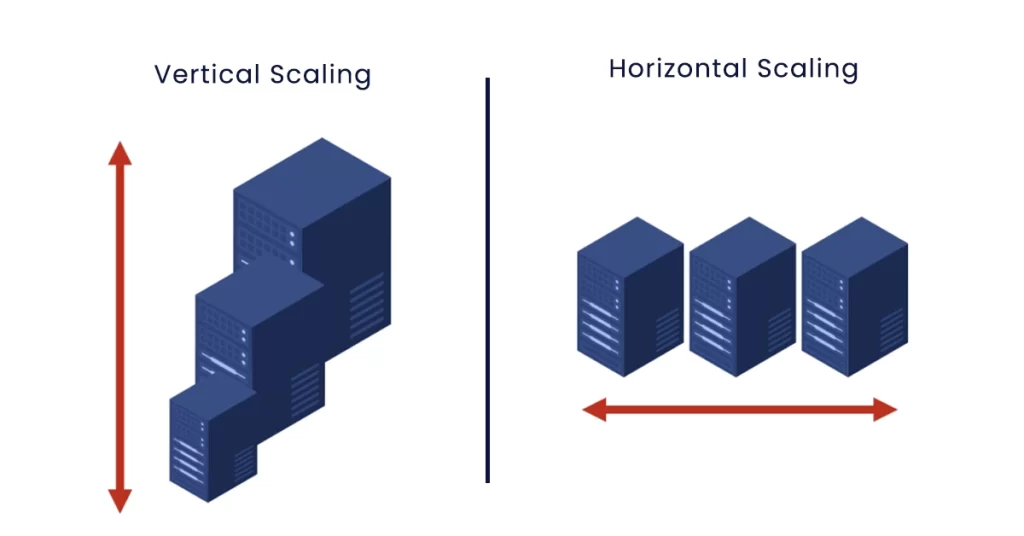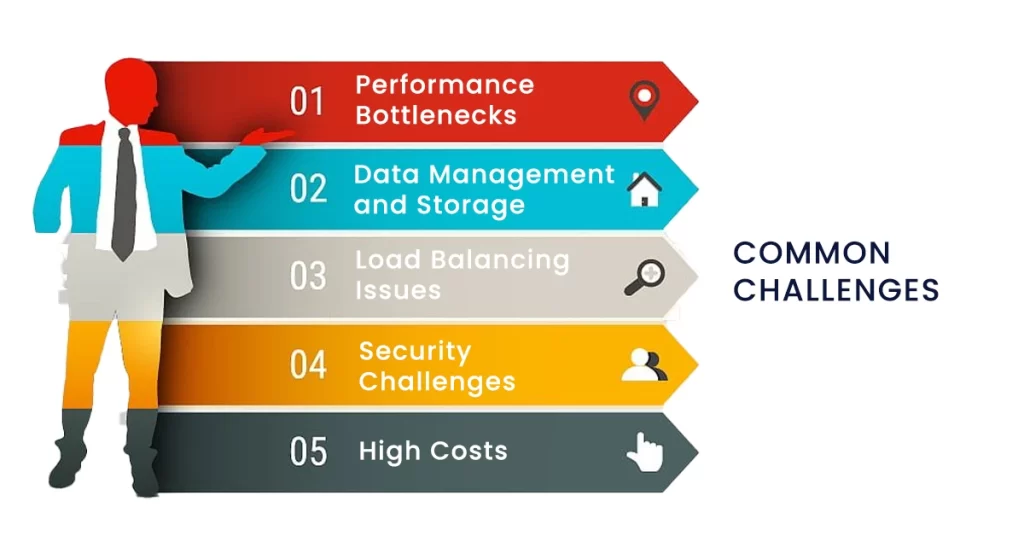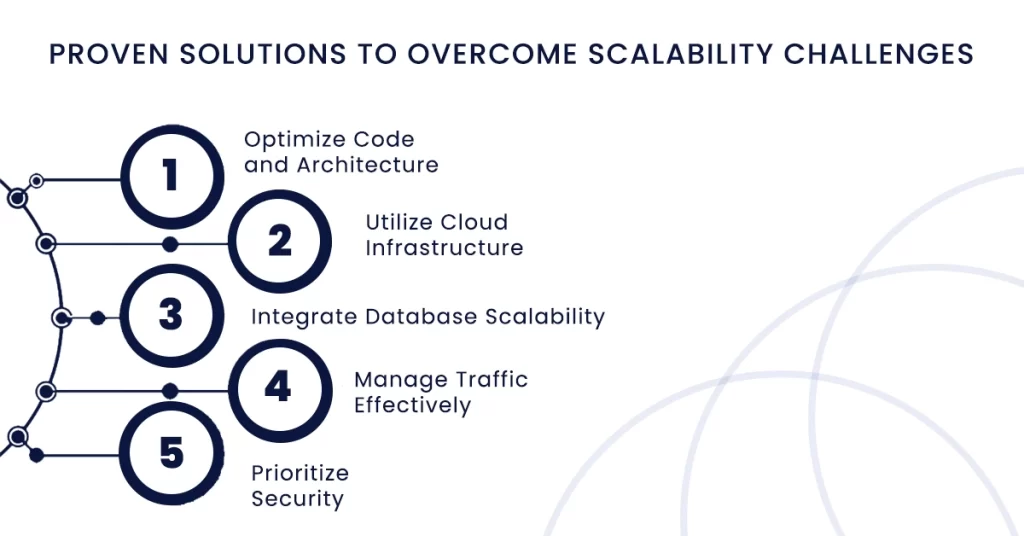Today, businesses require scalability against rapid and competitive environments. As a business evolves and changes, so too do its needs for software systems.
For instance, research conducted by Statista indicates that the market for enterprise software worldwide is expected to reach nearly $575 billion by 2026, an indication that companies are increasingly using software solutions to efficient operations and grow.
However, the catch is that building enterprise software is good, but making it scalable is even better.
Scalability refers to the ability of a software system to support increased workloads or growth along any dimension without an accompanying degradation in performance.
Failure to build scalable software can lead to performance bottlenecks and inefficiencies, resulting in lost revenues.
This blog will elaborate on the importance of enterprise software scalability, discuss the obstacles faced in building scalable systems and also provide tips on how to overcome these issues.
Table of Contents
Importance of Scalability in Enterprise Software

What Is Scalability?
Scalability in enterprise software refers to the software’s ability to manage and support an increasing load, without affecting its performance or reliability. There are two types of scalability:

Vertical Scaling:
This requires enhancing the capacity of a single server by increasing its resources (like CPU or RAM).
Horizontal Scaling:
This means a business can opt to load equally distributed requirements across multiple instances or servers.
For Instance in vertical scaling, the server may be upgraded with additional RAM to improve processing speed, and horizontal scaling involves adding additional servers to keep pace with the number of users or transaction increases.
Why does scalability matter?
In an enterprise environment, software is often critical, structurally forming a backbone for business operations from consumer data to the processing of financial transactions.
With business growth comes increasing demands on software infrastructure. Without proper scalability, the following issues can occur:
Performance bottlenecks:
Systems slow to a crawl or crash while dealing with larger volumes of users, data, or transactions.
Time loss:
Systems without sufficient scalability are likely to suffer outages versus loss of resources, thereby leading to loss of productivity and revenue.
Cost:
Resource inefficiencies can contribute to high IT costs without performance improvements.
Scalability is essential for growth. Consider the case of a rapidly growing e-commerce platform that failed to scale its software.
When the user base grew, slow page-loads, delays with processing orders, and complete crashes occurred during peak periods of shopping. Business was lost, customers became disgruntled, and carts were abandoned.
Common Challenges in Building Scalable Enterprise Software

Scalable software development comes with its own set of problems. There are some challenges related to the development of systems that can grow with the business which are faced by both developers and businesses.
Let’s explore some of the most common challenges and introduce potential solutions.
1. Performance Bottlenecks
As the number of software users goes up or as the volume of data being processed increases, the system’s speed can slow down.
It is usually the result of the inadequacy of infrastructure or the unsuitability of the code to hold the increase in traffic which causes degradation in the performance of the system.
Example:
Most of the software applications long run well-done versions which are rapidly delivered to the customers.
However, as the client base grows, due to poor architecture or insufficient infrastructure planning systems performance can be difficult to maintain.
Solution:
Optimizing databases, refactoring code, and becoming more network usage efficient are often the ways of catching and mending performance bottlenecks that might cause software to be overloaded and not be able to carry out a load effectively.
2. Data Management and Storage
The burden of managing a large amount of data is a problem that increases over time for a business organization.
Gain of data could result from slow queries to the database, bottlenecks, and a conflict of storage with the memory that may cause the computer to slow down the system.
Example:
Large enterprises are faced with database performance tuning issues such as slow queries, wanting several minutes to respond and even causing a temporary malfunction of a system when there is a request for connection.
Solution:
Distributed database, sharding, and NoSQL databases utilizing are several methodologies normally adopted to practically and smoothly sort out the issue of accumulated data and thereby to perform as the business scales.
3. Load Balancing Issues
Even delivering workloads to all the servers is a vital part to ensure the uptime and efficiency of the whole system. Nevertheless, load balancing a bigger and complex application can be a sticking point.
Solution Scalability with cloud and server less designs is typically the solution to this challenge by way of which a system automatically adjusts its resources.
4. Security Challenges
In the process of developing enterprise applications, there are increased concerns regarding security since the level of sophistication of cyber attacks increases with the number of potential points of entry.
This makes it difficult to keep systems secure while at the same time scaling.
Example:
Cost does not constitute a problem when scaling a business, however new emerging security risks that include data breaches and fraud due to complex architecture comes into play.
Solution:
To minimize this problem, systems should be designed in a way that they would incorporate security measures that scale such as micro services security, zero-trust architecture, encryption etc.
5. High Costs
There comes a time when the above actions can be scaled for precise expansion of a software system to increase revenues for the company except for high scaling tendencies that dwells badly when the scale aims are set poorly.
Poorly planned scaling plans can lead companies to employ employees higher than staying, especially when new technologies generating new costs are adopted for no justifiable basis.
Example:
It is needless to say that many problems arise when enlarging international expansion without a clear strategy center, especially the cost of infrastructure that is taken by the software as it scales.
Solution:
IT solutions that help improve effective directing of costs such as renewal cloud computing, containerization of IT applications and automation of all IT infrastructures would assist developers deploy their software at an affordable cost.
Proven Solutions to Overcome These Challenges

Various technical challenges in building scalable enterprise software have been outlined in the previous sections and it is worth looking at practical responses that may mitigate these challenges and design systems that are in a position to grow alongside the business.
1. Make Sure That You Optimize Code and Architecture For Scalability
Solution:
Scalability is appropriately built when building cleaner, more efficient, and well-structured code.
A crucial part of this is refactoring which means eliminating code smells, enhancing processes, and streamlining logics so that the system can support high loads with no drops in performance. Several issues are also addressed by architectural decisions.
Implementing scalable patterns such as micro services enables architectural components of the application to scale independently in order to avoid bottlenecks typical with monolithic architectures.
Besides this, caching techniques such as Redis or Memcached cut down the number of database loads in the application by storing commonly used data which enhances the speed of responses.
Example:
For instance, consider an e-commerce platform with high transaction volumes during peak sales periods. By adopting a services architecture, the checkout process, inventory management, and user authentication can all be decoupled and scaled separately.
If the checkout process becomes a bottleneck during peak traffic, you can scale that service independently without disrupting other parts of the application, ensuring a smoother experience for users and maintaining system stability.
2. Cloud Infrastructure for Scaling And Flexibility Solution
Solution:
The management of physical hardware limitations has been removed by the distributed infrastructure which provides the flexibility and the required tools to guarantee scalability.
Web services such as Amazon web services, Microsoft’s Azure and Google cloud are reliable solutions in that on demand resources are adjusted in accordance to real time needs.
Auto scaling options enable businesses to effectively manage the changing traffic which calls for increased computing power during peak hours and scale down when the traffic is normal.
Given this elasticity, applications are always performing optimally while incurring less in cost when there is lower demand.
Example:
When there are more users and the server load is higher, it’s more efficient to add power to a resource (in this case for example a cloud server) than trying to optimize the current server load through maintenance and adjustments.
For example, you can put adjustment limits at 500 concurrent users on the server.
Within reciprocal activity/users, it would be risky to perform such excessively risky manipulation of resources.
If there are 10 Leagues of users hitting the servers followed by periods during which the majority disconnect, it would make perfect sense to automatically provision resources as biological demand changes.
3. Implement Database Scalability Techniques
Solution:
As the enterprise applications commence their growth, managing a database becomes a chief matter of concern. Scaling up the databases involves several techniques: database partitioning, sharding, and a flexible, NoSQL approach such as MongoDB for unstructured data.
These techniques take off the burden from one database and add no bottleneck to a single database operation.
Databases can be horizontally scaled by simply adding more nodes to the system so as to handle wide varieties of data and thereby deliver greater query performance.
Example:
One global streaming outfit could use sharding to distribute user data across the globe.
Users from one region would get worldly access to only one shard, incrementally reducing the load on any single database, and stewardship the performance of other parts globally, in addition to faster queries and operations if they are performed on smaller, localized datasets.
4. Use Load Balancers for Efficient Traffic Management
Solution:
Load balancing is critical because these ensure high availability and performance in a scalable enterprise software set-up.
Load balancers help disperse incoming requested load on several servers, preventing any individual server from being saturated.
Regardless of using hardware or software load balancers such as NGINX or HAProxy, load balancing ensures that website hits can be handled during off-peak or peak loads.
Load balancers can also detect server failures, forwarding incoming traffic onto other servers in the network while maintaining integrity and performance, thus meeting high availability demand.
Example:
Consider a financial trading platform with users executing transactions simultaneously.
A load balancer can distribute the load across multiple servers, ensuring that no single server becomes overwhelmed, which could lead to delays or crashes.
This keeps the platform stable even during peak trading hours, maintaining a reliable user experience.
5. Prioritize Security during Scaling
Solution:
With an increase in scale comes an increase in potential security vulnerabilities. Hence, security should be integral to the scaling architecture.
A zero-trust security model, in which every request or command is authenticated and authorized, should be implemented so that no part of the system is taken for granted.
Regular security audits, data encryption, secure coding practices, and an effective firewall are essential as the system scales up.
Besides this, organizations should ensure compliance with the relevant regulations, such as GDPR, HIPAA, or PCI DSS, when scaling as security breaches can result in severe financial and goodwill loss.
Example:
A bank that scales its online banking app to cater to millions of customers across the globe might employ a zero-trust model, allowing requests for transactions, access, and communication between services only from authenticated sources.
The bank should encrypt all the customer data and run security audits from time to time to ensure that even as it caters to a large customer base, their data stays safe.
Adopting these solutions will help businesses address the primary challenges when building scalable enterprise software to ensure systems grow securely and alongside their business appropriately.
Proven Strategies to Overcome These Challenges
Having identified the common challenges, let us now focus on some proven strategies that can help you resolve these hurdles and develop truly scalable enterprise software.
1. Optimize Code and Architecture for Performance
The cornerstone of performance optimization lies in clean, efficient code and a resilient architecture.
For example, refactoring your code to remove redundancies, adding caching mechanisms, and adopting scalable architectural patterns such as micro services.
Example:
Micro services are an architectural style in which a single application is composed of many loosely coupled services. This ensures that different parts of the application can be scaled independently.
If your e-commerce platform is experiencing a surge in traffic during the checkout process, you can scale the checkout service without scaling the rest of the system.
2. Utilize Cloud Infrastructure for Flexibility and Scalability Solution
Incorporating cloud technologies like Amazon Web Services (AWS), Microsoft Azure, and Google Cloud can offer unmatched versatility when it comes to scaling.
One of such cloud only features is the capacity to automatically scale resources based on traffic, allowing companies to reallocate their resources based on demand while still ensuring high-quality performance.
Example:
Auto-scaling on cloud services ensures that businesses can scale resources up or down automatically during peak and off-peak hours, so that only the required resources are allocated while maintaining high-performance throughput and cost-effectiveness.
3. Integrate Database Scalability Solutions Solution
Using techniques like database partitioning, sharding, and utilizing NoSQL databases (like MongoDB) enable companies to more efficiently manage and retrieve data more efficiently, ensuring that no single database becomes a performance bottleneck.
Example:
Sharding is a technique used to separate database records across multiple independent servers.
This action helps distribute the work of all database requests to multiple servers, reducing the chances of a server getting overwhelmed.
4. Load Balancers-Maneuvering Traffic Effectively
Any load balancer, either hardware or software, facilitates distribution of the incoming user requests in a multi-server environment.
This indeed prevents the server from becoming loaded, thus alleviating performance issues in case of heavy traffic.
Example:
When systems are plagued with heavy traffic, load balancers can automatically redirect the traffic to the least-busy servers, improving the users’ experience without any downtime.
5. Security Comes First
In the process of scaling, make sure security is top-tier. The strategy of firewalls, encryption, frequent security audits, and a zero-trust model will help a lot in minimizing vulnerabilities while scaling out.
Example:
Zero-trust security postulate suggests that every interaction in a network is a threat, maintaining verifiability and guarantee of every access request as the scaling of the system increases.
Best Practices for Scalable Enterprise Software

Building scalable enterprise software is not a one-time effort that you complete and forget about. It requires careful planning and continued improvements to your system in order to grow and evolve with your business. Future-proof your enterprise software with these best practices:
1. Future-Proof with Automation
Implementing automation is paramount for maintaining scalability, adaptability, and operational stability.
By introducing DevOps and modernizing your approach to software development and Continuous Delivery and Continuous Deployment (CI/CD), you can automate nearly every stage of your software development, testing, deployment, and scaling.
Automation can reduce the risk of human error, enable fast software release cycles, and, most importantly, eliminate the need for manual intervention during new updates or scaling events.
For instance, a business that has an automated deployment pipeline can quickly and repeatedly deploy any size update into production, without downtime.
CI/CD pipelines can move small and frequent changes to production, reducing risk and improving agility.
Lastly, automation increases the efficiency of scaling in cloud environments by automatically increasing your servers’ resources in response to traffic.
2. Future-Proof with a Management Culture of Monitoring and Optimization
Moving forward, what will become critical is your ability to monitor your software’s key performance parameters 24/7.
System-performance monitoring tools like New Relic, Datadog, and Meta will provide insights and analytics in real-time that can help you find and resolve any performance or emerging problems before they affect an end-user.
You will need to use automated performance monitoring because performance problems are hard to identify, and if not identified, they will continue to get worse.
A production deployment of a large internal enterprise application will use a performance-monitoring solution like Data dog to monitor CPU and memory usage in real-time.
It will alert your team of the usage levels and notify them if it approaches the availability threshold. And a proactive capability can even allow a performance processor to be able to overcome obstacles before it is related to the user experience.
3. Planning for the Future Growth
Scalable enterprise software should be designed keeping in mind long-term growth.
Variable architecture of software and flexibility of infrastructure should also allow the addition of new features, technologies, and user requirements.
Future-proof systems are modular and hence can easily respond to future requirements changes, thus enhancing the feasibility of system development and expansion by enabling developers to update and modify specific components without imposing disruptions on the entire system.
Imagine a modular CRM that can easily be enhanced with new features such as AI-based analytics or further third-party integrations.
This will help to free up future releases to separate modules, allowing the system to grow and develop without any major redevelopments, thereby rendering it resilient to changes in business needs or advances in tech.
Conclusion
Scalability is paramount among the other premises in successful enterprise software development.
Building a model capable of scaling up is no bed of roses-from performance bottlenecks to data management and security-it certainly has its fair share of challenges.
However, with the right strategies, these challenges can be met.
We have discussed the importance of scalability in enterprise software, what common challenges it poses, and we have offered insight and advice on resolving each of these issues.
Optimizing code and architecture, employing cloud infrastructure, creating scalability for the database design, and utilizing security, all combine together to enhance the scalability of your enterprise-level software effectively.
Are you facing challenges in scaling enterprise software? Don’t wait until you are inside the sinking boat.
Let’s team together and develop a scalable and future-proof solution for your business needs. Call up our expert team today!
FAQs about Enterprise Software
1. What is scalability in Enterprise software?
Scalability refers to a software system’s ability to manage and support an increasing workload or growth without degrading performance or reliability.
It ensures that as a business grows, its software can handle more users, data, or transactions effectively.
2. Why is scalability important for businesses?
Scalability is crucial because it prevents performance bottlenecks, minimizes downtime, and reduces operational costs.
As businesses grow, they require software that can handle increased demands to avoid loss of revenue and customer dissatisfaction.
3. How can businesses overcome performance bottlenecks?
Businesses can optimize databases, refactor code, and enhance network efficiency to alleviate performance bottlenecks.
Implementing micro services architecture can also help in isolating and scaling parts of the application independently.
4. What database scalability techniques can be used?
Techniques such as database partitioning, sharding, and utilizing NoSQL databases like MongoDB can help manage large data volumes effectively and improve query performance without overwhelming a single database.
5. How important is security in scalable software?
Security is crucial when scaling software, as the number of potential vulnerabilities increases with the number of entry points.
Implementing a zero-trust security model, regular audits, and data encryption can help mitigate security risks during scaling.


